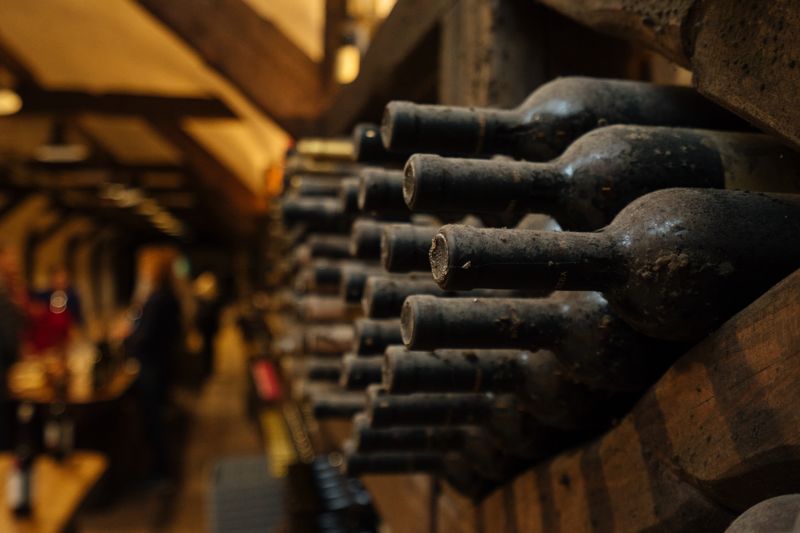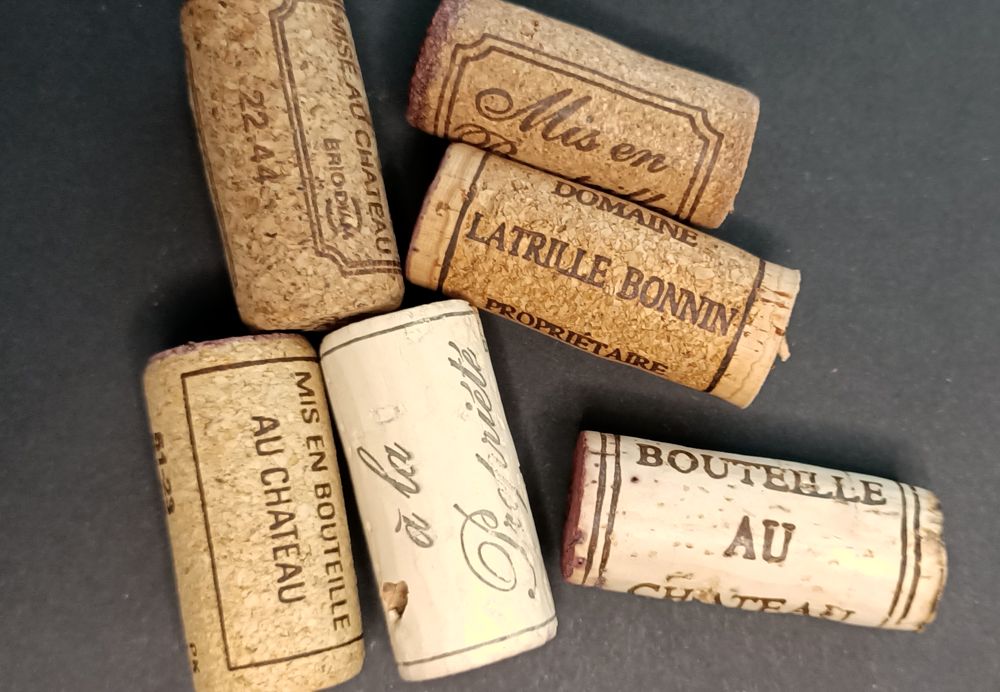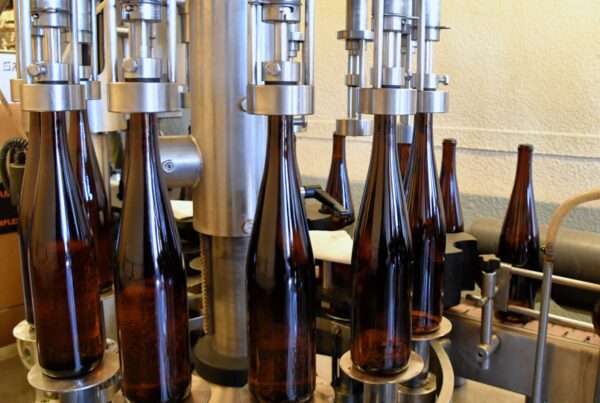There is no need to panic if you find mould on the cork of that special bottle of wine that you are about to open.
Mould on aged wine bottles can, if anything, be a sign that it was stored correctly.
Let’s talk about why it happens and how to evaluate if you can still drink the wine inside.

Contents
Why do wine corks get mouldy?
Wine cellars and refrigerators have higher levels of humidity than a standard fridge in order to prevent the corks from drying out.
Most cellars and fridges also allow bottles to rest horizontally to keep the wine in contact with the cork, preventing evaporation; however, evaporation can still happen over time.
Humidity in wine cellars is usually between 50% and 80%. While beneficial for the corks, such high levels of humidity also encourage mold spores. As such, most wine collectors will experience mold in their cellars at some point.
The mold in your cellar should not be a cause for concern about the wine itself.

How to remove mould from wine bottles and corks
Mould on a wine bottle or the top of a cork and be removed by wiping with a clean, dry cloth.
If you wish to clean stubborn mould from the bottle, you can clean with a solution equal parts vinegar and water; however, a vinegar solution is not recommended for the lip of the bottle. You don’t want to risk your wine tasting like vinegar!
Ensure the cork is completely dry before resealing the wine bottle.
Does mould on wine corks affect the wine?
Evaluate the condition of any wine bottles or corks affected by mould.
Most wine bottles have a metal or wax seal which prevents any mould that may be on the bottle from affecting the wine.
Where the mould is limited to cork that is on the outside, the wine is likely to still be enjoyable.
When mould has infiltrated the wine, it’s best to discard it as mould can impart musty or unpleasant flavors to wine.
If the cork has been affected and protrudes from the neck, the wine is likely to be oxidized and undrinkable.

How to prevent mould forming on wine corks
Proper storage and handling of wine can help to ensure your wine remains sealed and safe from mould and other dangers.
See guidelines below on how to store wine correctly:
Optimal temperature and humidity
The main reason for mould growth on wine corks is fluctuations in both temperature and humidity.
To prevent mould, ensure your wine is stored in a consistent environment.
Storing wine long-term requires a cool and consistent temperature – between 50°F and 59°F (10°C and 15°C). Humidity should be around 60-70%.
This environment is difficult to replicate in a regular home. Wine fridges can be excellent investment as they offer controlled temperature and humidity levels ideal for wine storage.
Good Ventilation
Stale air can cause mould to develop. So good ventilation is essential for wine storage.
Ensure that air can circulate freely. That said drafts can cause rapid temperature changes that can affect wine, so try to prevent or avoid drafts.
Store wine bottles horizontally
Storing wine bottles on their sides ensures that the cork stays in contact with the wine, preventing it from drying out. A dry cork can shrink or become brittle and prone to mould.
Maintain a clean environment
Clean and dust your wine storage area on a regular basis. Dust and dirt can contain mould spores that settle on wine bottles and corks. A clean environment reduces the likelihood of this happening.
Monitor your wine regularly
Inspect wine bottles on a regular basis. Check for any signs of damage or irregularities in the cork, such as cracks or protrusions.
Avoid extreme temperature changes
Rapid changes in temperature, such as moving wine from a warm area to a cold cellar, can create condensation on corks.
The moisture from the condensation can lead to mould growing on your wine bottles and corks. So, gradual changes in temperature are preferable.

How to tell if wine is gone off or bad
If you have cleaned the wine cork and poured your wine, but you are still unsure if it is okay to drink, it’s time to evaluate it to check for wine faults.
There are a number of wine faults that can cause wine to smell and taste bad.
Here are the most common faults and how to identify them:
Cork Taint (TCA)
Causes: Cork taint is caused by the compound TCA (trichloroanisole) and results in a musty or wet cardboard smell. It can lead to muted wine flavors.
How to Identify: Pour some wine into a glass and sniff immediately. If it smells musty or like wet cardboard, it probably has cork taint. TCA can be detectable even in small amounts.
Tainted wine is harmless but the wine will not taste nice.
Reduction in wine
Causes: Reduction occurs when wine hasn’t received enough oxygen, leading to unpleasant aromas like rotten eggs or burnt rubber.
How to Identify: Pour some wine into a glass and smell. If it smells bad like boiled cabbage or rotten eggs, it could be due to reduction. Sometimes introducing oxygen can cause the bad aromas to dissipate. Swirl the wine around the glass to introduce oxygen. If the unpleasant odors reduce in intensity or change into more pleasant ones, it was probably due to reduction.
Excess Sulfur Dioxide (SO2)
Causes: Excessive sulfur dioxide can lead to a burnt match or rubbery smell. It can often be accompanied by a metallic taste.
How to Identify: Pour some wine into a glass and smell. If it has a sharp, pungent odor or smells like burnt matches, it may have too much SO2.
Oxidized wine
Causes: Oxidized wine often has a brownish or brick-red tinge and may smell like vinegar, sherry or stale nuts. It may also taste flat and lackluster.
How to Identify: Observe the color of the wine. If it’s significantly browner than expected for its age or has vinegar-like notes, it may have undergone oxidation.
Volatile Acidity (VA) in wine
Causes: High levels of volatile acidity can result in a vinegar-like smell and a sharp, unpleasant taste.
How to Identify: Pour some wine and sniff. If it has a strong vinegar-like smell or if it smells like nail polish, it has probably been affected by volatile acidity. It will also taste noticeably sour.
Brettanomyces (Brett)
Causes: Brettanomyces yeast can impart barnyard, horse sweat, or smoky aromas to wine. In small amounts, some people enjoy these aromas, but it can be considered a fault if too pronounced.
How to Identify: Pour some wine into a glass and sniff it. If you can detect earthy, leathery, or barnyard-like scents, it may be due to Brettanomyces.
Out of Condition wine
Causes: This can occur due to poor storage conditions that result in the wine losing its vitality, freshness, and balance. It may taste dull and lifeless.
How to Identify: Pay attention to the wine’s color, smell, and taste. If it lacks vibrancy and complexity or has muted flavors, it could be out of condition.
Decanting wine
Wine corks with mould are likely to be aged wines.
Aged wines with a deposit will likely need to be decanted into a decanter.
Decanting will help the wine to open up.
Read with confidence: I am a certified wine expert (WSET L3).





